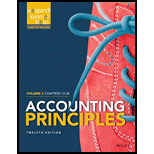
(a)
Trend Analysis: Trend analysis is an extended feature of horizontal analysis that enables the user to get the trend for a particular account during a relatively longer time period. It makes the base year’s amount as 100 and then calculates the percentage for the amount of following years.
Profit Margin: Profit margin ratio reflects the portion of net income in the net sales. It is a profitability measure tool that is used to evaluate the net income a business earns on every dollar of net sales. It is computed as net income divided by net revenue.
Asset Turnover: It is the extended form of
Return on Assets: It is a measure of net income earned on the basis of total assets used in the business. A company’s rate of return on assets shows the amount earned as the percentage of average total assets.
Return on Common
Debt to Assets Ratio: It is the ratio between total assets of the company and the total liabilities. Debt ratio reflects the finance strategy of the company. It is used to evaluate company’s ability to pay its debts. Higher debt ratio implies the higher financial risk.
Times Interest Earned: It reflects company’s earnings as the times of its interest expenses. It is used to evaluate the ability to pay interest expense, a company has. Higher ratio is preferred as it enables to pay the obligation of interest.
To prepare: The trend analysis of (1) net sales and (2) net income for Company A.
(b)
To evaluate: The profitability of Company A for 2012 and 2013 based on the (1) profit margin, (2) asset turnover, (3) return on assets and (4) return on common stockholders’ equity.
(c)
To evaluate: Company A’s solvency for 2012 and 2013 based on the (1) debt to assets ratio and (2) times interest earned.
(d)
To identify: The useful information outside annual report to evaluate a company for investment.
Trending nowThis is a popular solution!

Chapter 18 Solutions
Accounting Principles, Volume 2: Chapters 13 - 26
- I am looking for the correct answer to this financial accounting problem using valid accounting standards.arrow_forwardCan you help me solve this general accounting question using the correct accounting procedures?arrow_forwardEcho Corporation had accounts receivable of $95,000 at January 1, 2023. At December 31, 2023, accounts receivable was $75,000. Sales for 2023 totaled $650,000. Compute Echo Corporation's 2023 cash receipts from customers.arrow_forward
- O'Keeffe Corporation's trial balance shows Accounts Receivable with a debit balance of $350,000. The company estimates that 3% of receivables will be uncollectible. If the Allowance for Doubtful Accounts has a credit balance of $4,200 before adjustment, what is the required adjusting entry for bad debt expense?arrow_forwardAziz Industries has forecasted sales of $6,200 in April, $7,800 in May, and $9,400 in June. All sales are on credit. The company collects 35% of sales in the month of the sale and the remaining 65% in the following month. What will be the balance in accounts receivable at the beginning of July?arrow_forwardNonearrow_forward

 AccountingAccountingISBN:9781337272094Author:WARREN, Carl S., Reeve, James M., Duchac, Jonathan E.Publisher:Cengage Learning,
AccountingAccountingISBN:9781337272094Author:WARREN, Carl S., Reeve, James M., Duchac, Jonathan E.Publisher:Cengage Learning, Accounting Information SystemsAccountingISBN:9781337619202Author:Hall, James A.Publisher:Cengage Learning,
Accounting Information SystemsAccountingISBN:9781337619202Author:Hall, James A.Publisher:Cengage Learning, Horngren's Cost Accounting: A Managerial Emphasis...AccountingISBN:9780134475585Author:Srikant M. Datar, Madhav V. RajanPublisher:PEARSON
Horngren's Cost Accounting: A Managerial Emphasis...AccountingISBN:9780134475585Author:Srikant M. Datar, Madhav V. RajanPublisher:PEARSON Intermediate AccountingAccountingISBN:9781259722660Author:J. David Spiceland, Mark W. Nelson, Wayne M ThomasPublisher:McGraw-Hill Education
Intermediate AccountingAccountingISBN:9781259722660Author:J. David Spiceland, Mark W. Nelson, Wayne M ThomasPublisher:McGraw-Hill Education Financial and Managerial AccountingAccountingISBN:9781259726705Author:John J Wild, Ken W. Shaw, Barbara Chiappetta Fundamental Accounting PrinciplesPublisher:McGraw-Hill Education
Financial and Managerial AccountingAccountingISBN:9781259726705Author:John J Wild, Ken W. Shaw, Barbara Chiappetta Fundamental Accounting PrinciplesPublisher:McGraw-Hill Education





